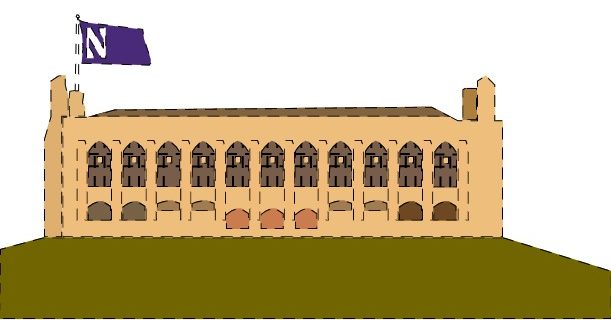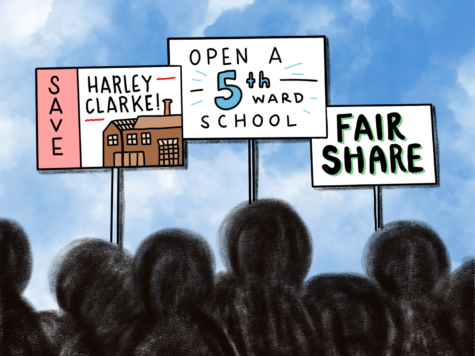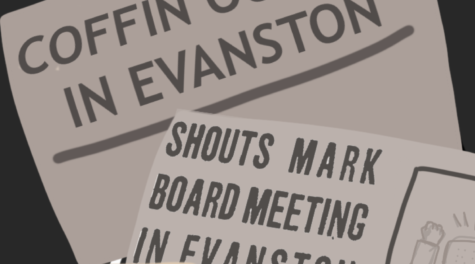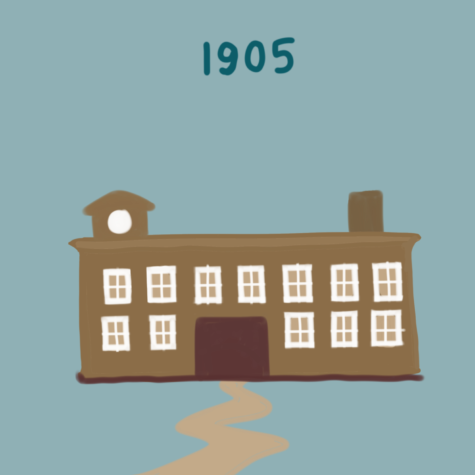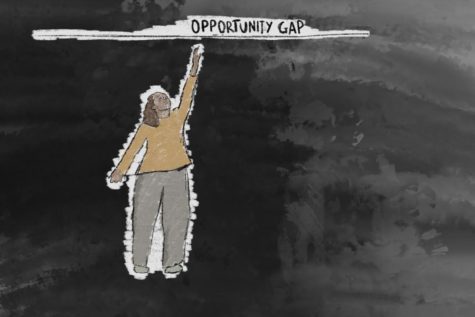Your donation will support the student journalists of the Evanstonian. We are planning a big trip to the Journalism Educators Association conference in Philadelphia in November 2023, and any support will go towards making that trip a reality. Contributions will appear as a charge from SNOSite. Donations are NOT tax-deductible.
Illustration by Lila Portis
The foundation of Northwestern and Evanston’s bond: a history of partnerships and conflict
January 28, 2022
Since the founding of Northwestern, the North Shore has established itself as a community built on moral values associated with the religious and intellectual influences of the university.
Formative years of Northwestern led to the founding, growth of Evanston
Evanston and Northwestern University’s history is so entangled and intertwined, it is easy to forget which was the predecessor.
However, Northwestern has asserted its dominance and control of the North Shore for nearly 200 years, shaping the cultural and intellectual framework of its surrounding city.
Northwestern came first. The founding of the school was in January of 1851, by founders such as John Evans and Orrington Lunt. These names sound familiar to any Evanston resident, largely due to their appearance throughout the city; Evans is the namesake of Evanston, and Lunt has streets, parks and an elementary school dedicated to him. The university settled in its current coastline home, and, in 1853, the founding members of the school officially purchased the 379-acre property. This purchase occurred prior to the establishment of Evanston, which didn’t happen until 1863.
Evanston and Northwestern’s history intersects and overlaps numerous times, often with the two entities at odds with each other. Yet, there has always been partnership and connection, especially when it comes to education and civil movements.
“Northwestern University was founded by Methodists. So that’s where that political outlook really comes from. Northwestern and Garrett Seminary, and then the small women’s college established the tone of education being important in the early years, the 1850s. That really made the people who moved to Evanston make it this place where education is valued, and [where there is] the importance of church-going and moral reform movements. All of it kind of sets this tone, and that tone stays with us through all of these years,” Lori Osborne, the director of the Evanston Women’s History Project (EWHP) and a historian at the Evanston History Center (EHC), says. “It’s not a coincidence as citizens of a place where we’re grappling with issues around race and reparations. It doesn’t surprise me having seen what was happening in those early founding years.”
Northwestern historian and archivist Kevin Leonard elaborates on Northwestern’s origins, specifically the purpose of the university.
“Northwestern was founded through the efforts of nine transplants to the city of Chicago, all professing membership in what was then known as the Methodist Episcopal Church. We know that denomination today by its modern name of the United Methodist Church. In 1851, the year Northwestern was founded, Chicago was a city of about 30,000 people, which is small by our appreciation of Metropolitan Chicago today. But at the time, it was a fairly significantly sized community, and more importantly, growing rapidly,” Leonard says. “So the nine founders of Northwestern decided that Chicago was a growing concern. They certainly were involved in making their own marks on the city and in various professional fields. But they thought that the city would grow [and] that there was a future to the city of Chicago and the Chicago region. Like people of other religious backgrounds, they wanted to establish an institution of higher education affiliated with their denomination.”
The key founders of Northwestern had a united mission of establishing a school under Methodist principles and ideas that catered to the growing Midwest region.
“Most American colleges and universities established prior to the 20th century were allied with religious denominations, so this was an opportunity for the Methodists in this community to plant their flag, at least in the realm of higher education, and have a flagship institution,” Leonard explains. “They received a charter from the state legislature of Illinois in 1851. If you look at Northwestern’s formal seal, it’s [from] 1851, [which is] when Northwestern came out as a legal corporate entity. It took several years for them to raise the money to acquire land, build a building and hire faculty. Northwestern didn’t open its doors to students until November of 1855. So between 1850 and 1855, there [were] a couple of projects that the founders had to embark upon. One was selecting a location.”
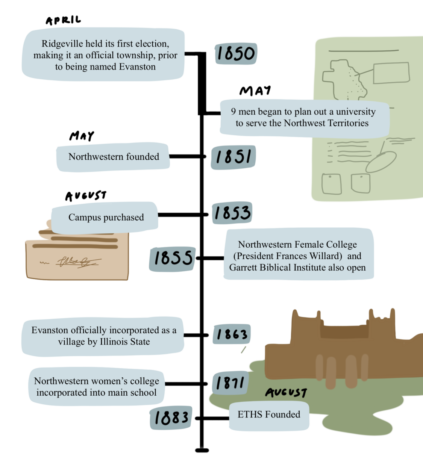
When choosing a site for the university, the founders were drawn to the North Shore, a fairly underdeveloped area at the time dedicated primarily to trade along the Green Bay Trail.
Established in large measure by the founders of Northwestern University, [they] acquired so much of the land in this area and planted it and made it available for sale largely from these. It came through the appeal of this community, to the appeal of this area to like-minded settlers. Northwestern, early on, amended its charter from the state of Illinois to include a four-mile limit on the sale of alcohol from the university. So there was a line drawn [which] prohibited alcohol within that radius. And that meant for people who abstained from consuming liquor or people of like mind who didn’t appreciate liquor that this would be a salubrious, healthy community for people who have similar interests. So one of the key social planks in the Methodist platform was abstinence from alcohol,” Leonard says.
Furthermore, Osborne connects the mission of the various components of Northwestern to early reform movements occurring in Evanston during its formative years. Most notably, the efforts of Frances Willard, a prominent figure in the temperance movement, formed the Christian Women’s Temperance Union, an international organization that was headquartered in Evanston.
“[Willard] becomes the Dean of Women when Northwestern becomes co-educational [in 1871] and goes on to found the largest women’s organization in the world,” Osborne adds. “No one in Evanston thinks it’s unusual that the most famous person in their town is a woman. And she’s a reformer. This is just the way this community was built.”
In the early years, as Osborne and Leonard express, Northwestern instituted a set of moral values which created the foundation for Evanston, but Evanston was not the first town to utilize this land. Previously, there had been settlers and Native tribes. According to the Mitchell Museum of the American Indian, Evanston’s location was previously the land of the Ho-Chunk, Ottawa, Miami and Potawatomi tribes.
Then, in 1832, the Green Bay Trail was established as a connection between Chicago, Ill. and Green Bay, Wis., resulting in the formation of small villages along the trail, such as Ridgeville, which stood where Evanston is today. The name Ridgeville first appeared in 1851, almost simultaneously with the establishment of Northwestern, primarily due to their similar reasons of origins.
During the mid-19th century, a wave of people coming from Chicago began to settle in what would be known as the North Shore. Both the settlers of Ridgeville and the founders of the university saw the opportunity in purchasing large tracts of this land and modeling the community they desired.
The Ridgeville Park District, a private district located in Evanston dedicated to preserving the history and land of Ridgeville, states on its webpage that “In 1857, the General Assembly of Illinois, by special act, provided that the Township of Evanston consist of all of Township 41, Range 14 (Ridgeville) and one mile out of Township 41, Range 13 (Niles). The land that would become the City of Evanston was purchased from Dr. John Foster by a group of Methodist businessmen for a university.”
“There had been people living in this area prior to Northwestern, in a town [that] was not known as Evanston. The point of the name came in recognition of John Evans, the leader among Northwestern founders, and in recognition of the place that Northwestern sat, as Northwestern University has been the leading institution of this area. So they named [the area] Evanston,” Leonard says in response to the shift from Ridgeville to Evanston.
The switch from Ridgeville to Evanston was a transition spanning over decades. The Ridgeville Park District shares that there is historical confusion on when Ridgeville was officially tied into Evanston because of civil disputes.
“There is evidence that, as late as 1902, residents of the area known as Ridgeville still considered themselves Ridgeville residents and considered Evanston to be the land purchased by Northwestern University,” the Ridgeville Park District website states.
This misconception may be rooted in the integral role of Northwestern in forming Evanston. Funding and population were key ways the university reared the town into the domestic haven the founders desired, primarily through overseeing the establishment of religious institutions and schools.
“Northwestern influenced the character of the community beyond just being an educational institution, and the chief educational institution, in the region, influencing the composition of that community in that other manner. Now, it’s not to say that people who founded Northwestern had issues with the foreigners and people of other denominations. But overriding that was this four-mile limit, and that gave him arguably a more wholesome character to what we call Evanston,” Leonard outlines.
Education is a key part of the identity of the City of Evanston.
— Devon Reid, Eighth Ward alderman
Northwestern’s influence runs deep in Evanston and, as Leonard states, Northwestern is responsible for the creation of the city and township currently in existence and the residents it historically attracts.
“The city of Evanston, we’re overall a highly educated city. We have Northwestern University here, which, of course, attracts a lot of highly educated [people] and folks who are on their way to becoming highly educated folks to our town. And, so, that is a benefit. Education is a key part of the identity of the City of Evanston,” says Eighth Ward alderman Devon Reid.
Northwestern’s formative years laid the groundwork for the city surrounding the internationally renowned research institution. However grateful Evanstonians may be for the resources, ideas and influence the university has shared with the city, there has been a fair share of conflict and tension.
Northwestern and Evanston’s relationship in the modern era
Across the blocks and streets of homes in Evanston, many residents have rectangular signs displayed in their front yard—some to commemorate graduations, others to express support for political candidates. Only one of these signs, however, targets the foundation of Northwestern and Evanston’s complex relationship: a sign urging Northwestern to pay its “Fair Share.”
In March of 2000, 83.5 percent of voting Evanston residents casted their ballot in support of the “Fair Share” referendum, an act that directly protested Northwestern’s tax-exempt status.
Following the vote, little progress was made on the matter—with yearly contributions to the City of Evanston still only hitting $1 million, despite Northwestern’s endowment of nearly $15 billion. However, the history of this dispute can be traced even further back.
Leonard explains the origin of Northwestern and the City of Evanston’s tax-related conflicts.
“Northwestern acquired a lot of property early on, and that property was not generating tax revenues for the city, so, as the city develops, and as more expenses [pile up], people have tended to look at this big institution, more than other big institutions, [like] the churches in town, [which] collectively are considerable and are on tax-exempt land,” Leonard says.
All in all, Northwestern occupies land that would otherwise bring the city an additional $40 million per year worth of property taxes. While non-profits are typically exempt from paying these taxes, with Northwestern being the wealthy, prestigious institution it is, many residents and city officials feel that the university is obligated to contribute.
In fact, other tax-exempt universities ,such as Princeton and Yale, contribute far more to their host cities—$21 million and $15 million respectively. Northwestern’s monetary benefactions come in the form of their “Good Neighbor Fund.” Starting in 2015, the university has contributed $1 million annually to jointly agreed upon projects in Evanston; for example, the 2021 initiatives revolved around strengthening racial equity.
While that funding has been a vital component of Evanston’s budget, school districts—the beneficiaries of 70 percent of property tax revenue—receive nothing. Other states, such as Massachusetts, have plans that require tax-exempt institutions to pay 25 percent of the normal property tax rate. Under that proposal, the school districts could receive as much as an additional $8 million from Northwestern per year.
“Northwestern has 100 percent been selling the school districts short. I’d say the city has gotten its fair share from Northwestern,” Reid expresses. “And I think that doesn’t just follow Northwestern. I think it’s probably [on the] community too. It’s our responsibility to demand of our neighbors an expectation that they’re good neighbors and they contribute fully to the fabric of our city.”
Reid’s call-to-action doesn’t mean Northwestern would lose their tax-exempt status; it just means the university would give back to the future generations of their community.
“Northwestern, if they really want to benefit the community, would be coughing up a whole lot more money to ETHS and [District 65]—to the tune of several million dollars a year, which would have a tremendous effect on both districts’ annual budgets,” Reid further reflects.
Ultimately, these problems don’t just arise between the city, school districts and Northwestern. Evanston has to make up for this loss of revenue somewhere, and in this case, that money comes straight from the pockets of Evanstonians.
“There’s tensions between neighbors, particularly close to the campus and the university around things like off-campus student housing [and] the university purchasing property, which essentially takes the property off the tax rolls and results in increased property taxes,” Evanston mayor Daniel Biss says.
On the other hand, Northwestern might make up for this loss of tax revenue by contributing in other forms.
“To me, the benefits of having an institution like this in the community far outweigh any of the difficulties that have arisen over the years,” Leonard explains. “There is money that’s spent by Northwestern students, by Northwestern itself and by Northwestern faculty in this community [by] going to local merchants and [paying] local taxes. There is taxation on the sale of athletic tickets, so a well-attended football game makes a significant contribution to the City of Evanston.”
Taxation isn’t the only conflict that has emerged between the two groups. The late 1900s was a time marked by social justice movements, and Northwestern’s campus was no exception to this. After a “noisy rally” was held by more than 1,000 Northwestern students in May of 1972 to protest the Vietnam war, the Evanston Police Department billed Northwestern for the additional police force and equipment used to quell protesters—a bill Northwestern ultimately refused to pay.
This wasn’t an isolated incident. Too often was Northwestern on the wrong side of history, and too often did its students have to respond ferociously to their school being behind the times—leaving the City of Evanston right in the middle.
However, in comparison to land and tax conflicts, these political sparks did little to alter the relationship between the two institutions.
“If you’re looking at the 1960s, development of a youth culture and the types of behaviors that might be associated by some of that youth culture, rebelliousness, defiance, drug or alcohol use, political opposition to more mainstream values,” Leonard says, “I don’t know if I consider [that culture] too serious an issue—these things peak and valley. To me, they don’t seem to be long lasting. The long lasting conflicts between Northwestern and the broader community have been over [use of] land and taxation, rather than behavioral issues or politics.”
Nonetheless, in spite of the tension between Northwestern and Evanston, the two groups have managed to partner in meaningful, beneficial ways. In 2012, Northwestern began its “Good Neighbor, Great University” initiative that allowed a series of collaborations to take place between the city and university—one of which created a partnership office in ETHS.
“Before the Partnership Office, there were a lot of things that went on, a lot of things that were built between the university and the high school, and that’s been going on for years and decades before the formal partnership, but things weren’t strategic or coordinated. So, it was about who knew who or who would reach out to who,” Partnership Coordinator Kristin Perkins reflects. “New students would come into Northwestern, they would have an idea, [but] they would have no idea whether it’s been done before or how to logistically go about it or who to contact. So, I think the biggest shift [is that we’re] more strategic, more coordinated, and we can be more visionary.”
Now, the office has between 85 and 100 different forms of collaboration each year, with four main areas of strategic partnership: diversity in STEM pathways, arts and design in STEM, college access and career pathways as well as identity and social consciousness.
Within the first area, diversity in STEM pathways, the partnership has created a Women in STEM group that connects with the Society of Women Engineers at Northwestern. New this year, another program allows Black and Latinx fellowship students at Northwestern to mentor students in ETHS math classes.
The second area, arts and design in STEM, is responsible for the STEAM Design and Innovation course, and the third area, college and career pathways, provides high school students with Northwestern’s resources. Students hear from renowned speakers, sit in on classes and start to figure out post-high school plans.
Finally, the last area, which revolves around social consciousness, led to the implementation of the Black male summit as a part of their Black Men Lead initiative—just the first of Northwestern’s many summits at ETHS.
“There are some areas of partnership that students may never directly see. For example, building the data visualization course, or we’re helping work with Ms. Litt, who is starting a BioTech course next year, and we’ve got a professor and graduate students who are going to be building these custom labs for her class. Students will do the labs, and they’ll see the course and things like that, but they may not know how deep the Northwestern partnership goes into that,” Perkins adds. “Whereas, others are very student focused; Black Men Lead is very student focused, Women in STEM is very student focused.”
Unlike many other college-high school partnerships, ETHS and Northwestern are unique in their dedication to ensuring the initiatives are mutually beneficial. Thus, while the Women in STEM program offers ETHS students a female-targeted mentorship program, the Northwestern students also gain research and outreach opportunities.
“I think that the partnership between the university and ETHS has helped folks be able to see different perspectives because this partnership is so unique, and it’s so focused on that mutual benefit. But, we have to find different ways of thinking and different ways of approaching common goals and be okay with that complexity and be okay with working through that,” Perkins says.
“We’ve intentionally done that and stuck with it, even when it’s uncomfortable, even when folks disagree, but we’ve stuck with it now for 10 years, and I think folks are starting to say, ‘Okay, we can agree on common goals.’ That’s a really good starting point.”
It’s not just ETHS and Northwestern benefiting from the formal partnership—the office has been able to connect with the Evanston Public Library, YMCA, Family Action Network and other organizations that all serve to make the community a better place.
Perkins has seen the ways that the partnership office has bridged the gap between Evanston and Northwestern.
“The Evanston community—that includes ETHS, includes the city, includes Northwestern—we’re all part of this one community, and we need to figure out ways of working together and figuring out what the joint goals [are]. What are the things that we can all agree are important to us, collectively as a community? And, then, how do we work towards those together?
“Even if the goals may be 20 years in the future or 50 years in the future, we can co-imagine what kind of world we want this to be and what kind of community we want this to be 50 years from now.”
Although conflicting viewpoints do come up from time to time between the two institutions, in general, ETHS and Northwestern have been able to build a productive relationship that has only strengthened since the partnership began.
“Complexity and struggle are not bad things; they’re not things that have to be avoided. They’re things that naturally come up when we’re all working towards this better collective future, and it doesn’t mean that anything’s wrong—it just means that we have different points of view,” Perkins describes.
“What I’m most encouraged by is that folks are coming to the table together to work through those [issues] together and say, ‘What kind of community do we really want to build together?’”
In recent years, admissions to Northwestern from ETHS have increased, along with diversity among the applicants from ETHS. Before the partnership, most ETHS students that applied to Northwestern either had family members that worked there or had other connections, but, through the office’s work, more students feel as though they can really belong at Northwestern—leading to an increase in overall applications to the university.
“The two home communities, [Chicago and Evanston], have a special relationship with ETHS and Chicago Public School (CPS) students. So students from ETHS and CPS do get kind of a longer look at their applications,” Perkins notes.
“But Northwestern is highly selective, and admissions is really competitive, so I never want to over promise. I’m always encouraged when students are interested in Northwestern, and I think it should be one of several schools that they’ve applied to, as with any highly selective school.”
From connections to ETHS or to the city overall, there is an inextricable link between Northwestern and Evanston. Despite their difficulties, Northwestern has been indisputably beneficial to the political, social and economic fabric of the city.
“It’s a positive resource—there’s no question in my mind. I don’t agree with everything, and there are times we have difficult conversations, and there are plenty of things I’d like to see change,” Biss says. “But to have that much teaching, scholarship and thinking occur right here is a really positive resource that we can all benefit from.
“But I also do it with the understanding that [Evanston] thriving requires a thriving Northwestern and thriving requires training. So, ultimately, what we need to find are solutions that work for both institutions.”
Reflecting on the perception of NU and Evanston
For over a century and a half, Northwestern has maintained an immense and influential presence in Evanston.
“Northwestern is an anchor institution in the City of Evanston. Given the size of Northwestern and the size of the City of Evanston, [Northwestern is] just a big deal culturally,” Biss says. “This town is affected by Northwestern; people work there or know someone who works there, or spend time there or [do] academic work for cultural opportunities. It just exerts a lot of gravitational force over the culture of our town.”
There are a multitude of components that allow Northwestern University to sustain its impact on Evanston, but one aspect of Northwestern is particularly apparent in its sway over the town: the students. With Northwestern students occupying an estimated 10 to 12 percent of Evanston’s demographics, they have established a heavy presence.
ETHS senior and committed class of 2026 Northwestern student Ben Gordon reflects on the influence that Northwestern had on him growing up.
“There are pictures of me when I was one or two with Northwestern sweatshirts on—it’s just [always] been a constant part of my life. That’s the type of connection I have,” Gordon explains. “Some of the landmarks,—the rocks [and] the beaches by there—those are the places I go to on a regular basis. That’s a lot of what the connection is. It’s just being so close to it, being so melded with it as a community is really nice and makes me feel really connected to the school.”
By the time college applications came around, this city-school relationship ultimately led Gordon to apply early decision to Northwestern. Between performing with the marching band on band day and having a Northwestern professor co-teach his math class, Gordon already had a unique connection to the university.
“Although [band day] is a very rough day because you have to wake up at five in the morning, it is really nice. You get to play with [Northwestern’s] marching band, you get to be out on the field at a football game, you get to have that experience, and it’s very connected,” Gordon elaborates. “You can really tell Northwestern really wants to be a part of Evanston. It doesn’t just want to be separate.”
In fact, ETHS, historically sends a significant number of students to Northwestern each year. According to SchoolLinks, in 2019, 50 students were accepted, 33 were declined and 45 application statuses are unknown, resulting in a total known percentage of acceptances as 39 percent. Yet, Northwestern’s typical acceptance rate is eight percent, which fell even lower in 2020.
“Growing up in a university town, [where] Northwestern and Evanston are so tightly linked is one of those things that ETHS students may not appreciate until they leave,” Perkins reflects. “So, oftentimes, I love hearing from these students who have graduated, and then enter college or their career, and they reflect on how unique the really deep connection with the university was. They kind of have this realization that, ‘Woah, it’s not always like that at different high schools.’”
However, despite this connection to ETHS students, Northwestern and Evanston have a long and complicated history that spans all the way back to the university’s founding. Relations between the students and the city spread all the way back to 1926, when the school and city joined forces to help stop a student riot that had swept through the school on Nov. 23. Northwestern students have always had a voice in matters relating to the university and Evanston. In the past, student groups and activists have protested and campaigned for local alderman elections and for better racial relations within the school.
Issues within Northwestern grew more serious as students seized two of the university’s administrative offices and barred entrances to employees in 1968. The protesters wanted more representation, scholarships, opportunities, classes for Black students and an increase in Black staff members. One student carried a placard saying “Black students occupy this building because the administration has turned a deaf ear.”
The protest was received differently around campus, with many students gathering outside the offices, to some even publishing in newspapers that the students demanded stereotypically Black foods to be served in the dining halls.
In 1972, Northwestern refused to pay a bill to the city for extra police services during a protest, arguing that they never specifically requested the services and therefore shouldn’t be charged for it. The city blamed the students for a march of over 1,000 people that began at Robert Crown and went down Sheridan Road. The event started as a protest to increase room and board rates but ended up as another rally against the Vietnam War. Barricades were placed on Sheridan Road that were eventually removed after three days.
Recently, student action groups advocated for students to vote in local elections. Groups like Reclaim Evanston, which canvasses for local politicians, encouraged more participation in elections, which started at the university. The group would speak at meetings to encourage voter participation focused on aldermanic elections, so they could focus on change in individual wards before they endorse a candidate for mayor.
In the end, there has and always will be a connection between Evanston and the university. Whether it’s people enjoying the rocks or attending Big Ten sporting events, Northwestern is a staple in the Evanston community.
“I don’t think I realized this until a couple years ago, but Evanston is a college town,” Gordon says.
“It’s a Northwestern town.”

